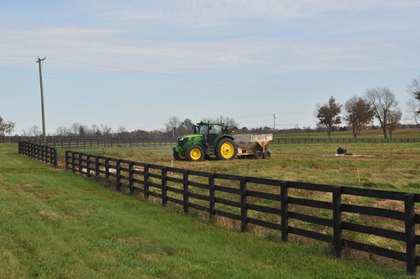Winterizing Pastures Starts in Fall

Winter is a hard season for horse owners. Water freezes, grass isn’t growing, and mud seems abundant. Winter is also hard on pastures, and a single winter of poor management can undo years of costly improvements. However, there are steps that can be taken to prepare cool-season pastures for winter and improve the pasture’s chances of weathering the cold season well.
Fall is an excellent time to submit a soil test to your county extension agent or agricultural dealership and apply lime, phosphorus, and potassium fertilizer as recommended. You generally won’t see nitrogen on your sample results as it does not persist in soil, but it’s that doesn’t make it any less important to maintaining a healthy pasture through the winter.
Fall Nitrogen Applications
A fall nitrogen application is a simple and relatively inexpensive step that can have big impacts down the line. Nitrogen is known to have the single greatest impact on plant growth, which is why hay producers apply it in the spring and summer to boost yield. However, the goal of pasture management isn’t necessarily producing as much forage as possible, but producing enough and to produce it when it’s needed.
Low nitrogen application rates in the fall will not result in significant growth increases, but will encourage plants to build root reserves. This will allow grasses to stay active longer into the winter, survive the potentially harsh conditions better, and green up earlier in the spring. All of these things can result in more winter and early spring grazing and, as a result, less need for supplemental hay.
These benefits are not limited to the winter and early spring months, however. Stronger plants are more likely to spread new tillers and fill in areas left bare by annual weeds or grasses.
One study by University of Kentucky (UK) researchers found that applying just 30 pounds of nitrogen twice in the fall increased percent cover by nearly 20% the following spring, compared to those areas not fertilized or only fertilized once. Thick grass stands shade out weeds and reduce summer weed pressure, especially for annuals such as crabgrass and ragweed. Larger root systems help grass stands survive summer droughts better because they are able to access more water in the soil. Further, fertilizer applications are generally easier in the fall. In most areas, fall is dryer than spring, making getting equipment onto fields easier and less destructive. Finally, nitrogen prices might be cheaper than during spring and summer months and farm supply stores or custom applicators will likely not be as busy during the fall.
Fall nitrogen for cool-season pastures is best applied in split applications of 30-40 pounds actual nitrogen per acre in September or October and again in October or November. For the transition zone, this is generally in late September or early October and again in November. Late summer or early fall applications can boost newly-seeded grasses, but could also boost still-active warm-season grasses, such as nimblewill and crabgrass. Nitrogen uptake by cool-season grasses will be minimal after a hard freeze (<20oF) and is not recommended. Check with your local county extension agent for timing recommendations.
While organic forms of nitrogen, such as animal manure, are excellent fertilizers, they will not benefit fall pastures the same way as inorganic sources, because nitrogen is bound to organic matter and requires warm temperatures to breakdown. Use highly soluble sources of nitrogen, such as urea or ammonium nitrate, for fall applications.
References and Resources
- Late Fall Nitrogen Fertilization For Cool Season Grasses
- Schwer, Smith, Huo, Keene, Lourie, Roberts and Morrison. Late Fall Nitrogen Applications for Horse Pastures. American Forage and Grassland Council, June 2009.
- Soil Sampling and Nutrient Management in Horse Pastures
Other Tips
This winter, consider using a designated sacrifice area for turn out and hay feeding to protect pastures. When pastures aren’t growing, they are unable to recover from grazing or traffic. However, horses will continue to graze plants even after they go dormant. Repeated grazing of dormant plants and hoof traffic can damage pastures, killing plants and thinning the stand.
Ideally, sacrifice areas are armored to keep dry footing under horses all winter long with geotextile fabric, rock, and dense grade aggregate. However, sacrifice areas do not have to be armored. If a pasture is already in poor health and slated to be improved the following year, it might be beneficial to designate it as a sacrifice area to protect other pastures in better health.
Take-Home Message
Preparing pastures for winter weather can help to minimize the impacts of horses and harsh weather, allowing managers to protect their investments in pasture improvements, reduce hay feeding and strengthen pastures for spring and summer grazing.
Ray Smith, PhD, forage extension specialist, and Krista Lea, MS, UK Horse Pasture Evaluation coordinator, both of UK’s Department of Plant and Soil Sciences, provided this information.
Want more articles like this? Sign up for the Bluegrass Equine Digest e-Newsletter.
More information on Gluck Equine Research Center and UK Ag Equine Programs.
Written by:
University of Kentucky College of Agriculture, Food, and Environment
Related Articles
Stay on top of the most recent Horse Health news with












